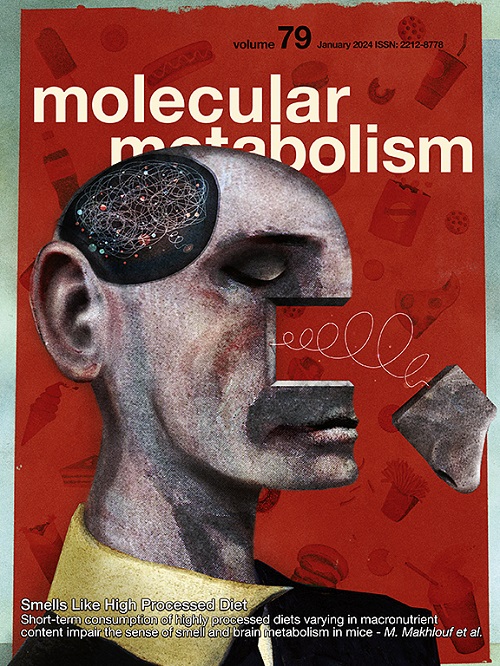Linking metabolism and histone acetylation dynamics by integrated metabolic flux analysis of Acetyl-CoA and histone acetylation sites
IF 7
2区 医学
Q1 ENDOCRINOLOGY & METABOLISM
引用次数: 0
Abstract
Objectives
Histone acetylation is an important epigenetic modification that regulates various biological processes and cell homeostasis. Acetyl-CoA, a hub molecule of metabolism, is the substrate for histone acetylation, thus linking metabolism with epigenetic regulation. However, still relatively little is known about the dynamics of histone acetylation and its dependence on metabolic processes, due to the lack of integrated methods that can capture site-specific histone acetylation and deacetylation reactions together with the dynamics of acetyl-CoA synthesis.
Methods
In this study, we present a novel proteo-metabo-flux approach that combines mass spectrometry-based metabolic flux analysis of acetyl-CoA and histone acetylation with computational modelling. We developed a mathematical model to describe metabolic label incorporation into acetyl-CoA and histone acetylation based on experimentally measured relative abundances.
Results
We demonstrate that our approach is able to determine acetyl-CoA synthesis dynamics and site-specific histone acetylation and deacetylation reaction rate constants, and that consideration of the metabolically labelled acetyl-CoA fraction is essential for accurate determination of histone acetylation dynamics. Furthermore, we show that without correction, changes in metabolic fluxes would be misinterpreted as changes in histone acetylation dynamics, whereas our proteo-metabo-flux approach allows to distinguish between the two processes.
Conclusions
Our proteo-metabo-flux approach expands the repertoire of metabolic flux analysis and cross-omics and represents a valuable approach to study the regulatory interplay between metabolism and epigenetic regulation by histone acetylation.

通过对乙酰辅酶和组蛋白乙酰化位点的综合代谢通量分析,将新陈代谢和组蛋白乙酰化动态联系起来。
组蛋白乙酰化是一种重要的表观遗传修饰,可调节各种生物过程和细胞稳态。乙酰-CoA是新陈代谢的枢纽分子,是组蛋白乙酰化的底物,从而将新陈代谢与表观遗传调控联系起来。然而,由于缺乏能捕捉特定位点组蛋白乙酰化和去乙酰化反应以及乙酰-CoA合成动态的综合方法,人们对组蛋白乙酰化的动态及其对代谢过程的依赖性仍然知之甚少。在本研究中,我们提出了一种新颖的蛋白质-代谢通量方法,该方法将基于质谱的乙酰-CoA 和组蛋白乙酰化代谢通量分析与计算建模相结合。我们根据实验测得的相对丰度,建立了一个数学模型来描述乙酰-CoA 和组蛋白乙酰化的代谢标记掺入。我们证明,我们的方法能够确定乙酰-CoA 的合成动态以及特定位点组蛋白乙酰化和去乙酰化反应速率常数,而且考虑代谢标记的乙酰-CoA 部分对于准确确定组蛋白乙酰化动态至关重要。此外,我们还表明,如果不进行校正,代谢通量的变化会被误解为组蛋白乙酰化动态的变化,而我们的蛋白代谢通量方法则可以区分这两个过程。
本文章由计算机程序翻译,如有差异,请以英文原文为准。
求助全文
约1分钟内获得全文
求助全文
来源期刊

Molecular Metabolism
ENDOCRINOLOGY & METABOLISM-
CiteScore
14.50
自引率
2.50%
发文量
219
审稿时长
43 days
期刊介绍:
Molecular Metabolism is a leading journal dedicated to sharing groundbreaking discoveries in the field of energy homeostasis and the underlying factors of metabolic disorders. These disorders include obesity, diabetes, cardiovascular disease, and cancer. Our journal focuses on publishing research driven by hypotheses and conducted to the highest standards, aiming to provide a mechanistic understanding of energy homeostasis-related behavior, physiology, and dysfunction.
We promote interdisciplinary science, covering a broad range of approaches from molecules to humans throughout the lifespan. Our goal is to contribute to transformative research in metabolism, which has the potential to revolutionize the field. By enabling progress in the prognosis, prevention, and ultimately the cure of metabolic disorders and their long-term complications, our journal seeks to better the future of health and well-being.
 求助内容:
求助内容: 应助结果提醒方式:
应助结果提醒方式:


